Related Research Articles
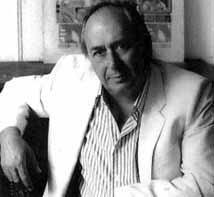
James Graham Ballard was an English novelist and short story writer, satirist and essayist known for psychologically provocative works of fiction that explore the relations between human psychology, technology, sex and mass media. Ballard first became associated with New Wave science fiction for post-apocalyptic novels such as The Drowned World (1962), but later courted political controversy with the short-story collection The Atrocity Exhibition (1970), which includes the story "Why I Want to Fuck Ronald Reagan" (1968) and the novel Crash (1973), a story about car-crash fetishists.
The New Wave was a science fiction style of the 1960s and 1970s, characterized by a great degree of experimentation with the form and content of stories, greater imitation of the styles of non-science fiction literature, and an emphasis on the psychological and social sciences as opposed to the physical sciences. New Wave authors often considered themselves as part of the modernist tradition of fiction, and the New Wave was conceived as a deliberate change from the traditions of the science fiction characteristic of pulp magazines, which many of the writers involved considered irrelevant or unambitious.

James White was a Northern Irish author of science fiction novellas, short stories and novels. He was born in Belfast and returned there after spending some early years in Canada. After a few years working in the clothing industry, he worked at Short Brothers Ltd., an aircraft company based in Belfast, from 1965 until taking early retirement in 1984 as a result of diabetes. White married Margaret Sarah Martin, another science fiction fan, in 1955 and the couple had three children. He died of a stroke.

Sam Youd was a British writer best known for science fiction written under the name of John Christopher, including the novels The Death of Grass, The Possessors, and the young-adult novel series The Tripods. He won the Guardian Children's Fiction Prize in 1971 and the Deutscher Jugendliteraturpreis in 1976.
Damien Francis Broderick is an Australian science fiction and popular science writer and editor of some 74 books. His science fiction novel The Dreaming Dragons (1980) introduced the trope of the generation time machine, his The Judas Mandala (1982) contains the first appearance of the term "virtual reality" in science fiction, and his 1997 popular science book The Spike was the first to investigate the technological singularity in detail.

James Edwin Gunn was an American science fiction writer, editor, scholar, and anthologist. His work as an editor of anthologies includes the six-volume Road to Science Fiction series. He won the Hugo Award for "Best Related Work" in 1983 and he won or was nominated for several other awards for his non-fiction works in the field of science fiction studies. The Science Fiction and Fantasy Writers of America made him its 24th Grand Master in 2007, and he was inducted by the Science Fiction and Fantasy Hall of Fame in 2015. His novel The Immortals was adapted into a 1970–71 TV series starring Christopher George.

The Magazine of Fantasy & Science Fiction is a U.S. fantasy and science fiction magazine, first published in 1949 by Mystery House, a subsidiary of Lawrence Spivak's Mercury Press. Editors Anthony Boucher and J. Francis McComas had approached Spivak in the mid-1940s about creating a fantasy companion to Spivak's existing mystery title, Ellery Queen's Mystery Magazine. The first issue was titled The Magazine of Fantasy, but the decision was quickly made to include science fiction as well as fantasy, and the title was changed correspondingly with the second issue. F&SF was quite different in presentation from the existing science fiction magazines of the day, most of which were in pulp format: it had no interior illustrations, no letter column, and text in a single-column format, which in the opinion of science fiction historian Mike Ashley "set F&SF apart, giving it the air and authority of a superior magazine".

Science Fantasy, which also appeared under the titles Impulse and SF Impulse, was a British fantasy and science fiction magazine, launched in 1950 by Nova Publications as a companion to Nova's New Worlds. Walter Gillings was editor for the first two issues, and was then replaced by John Carnell, the editor of New Worlds, as a cost-saving measure. Carnell edited both magazines until Nova went out of business in early 1964. The titles were acquired by Roberts & Vinter, who hired Kyril Bonfiglioli to edit Science Fantasy; Bonfiglioli changed the title to Impulse in early 1966, but the new title led to confusion with the distributors and sales fell, though the magazine remained profitable. The title was changed again to SF Impulse for the last few issues. Science Fantasy ceased publication the following year, when Roberts & Vinter came under financial pressure after their printer went bankrupt.
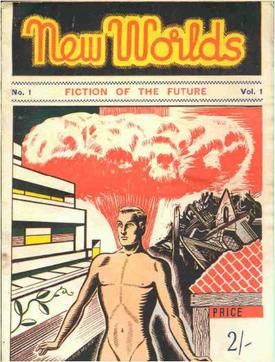
New Worlds was a British science fiction magazine that began in 1936 as a fanzine called Novae Terrae. John Carnell, who became Novae Terrae's editor in 1939, renamed it New Worlds that year. He was instrumental in turning it into a professional publication in 1946 and was the first editor of the new incarnation. It became the leading UK science fiction magazine; the period to 1960 has been described by science fiction historian Mike Ashley as the magazine's "Golden Age".
David Pringle is a Scottish science fiction editor and critic.
Edward John Carnell was a British science fiction editor known for editing New Worlds in 1946 then from 1949 to 1963. He also edited Science Fantasy from the 1950s. After the magazines were sold to another publisher he left to launch the New Writings in Science Fiction anthology series, editing 21 issues until his death, after which the series was continued by Kenneth Bulmer for a further 9 issues.
Lee John Harding was an Australian freelance photographer, who became a writer of science fiction novels and short stories.
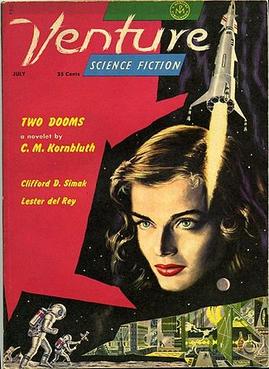
Venture Science Fiction was an American digest-size science fiction magazine, first published from 1957 to 1958, and revived for a brief run in 1969 and 1970. Ten issues were published of the 1950s version, with another six in the second run. It was founded in both instances as a companion to The Magazine of Fantasy & Science Fiction. Robert P. Mills edited the 1950s version, and Edward L. Ferman was editor during the second run. A British edition appeared for 28 issues between 1963 and 1965; it reprinted material from The Magazine of Fantasy & Science Fiction as well as from the US edition of Venture. There was also an Australian edition, which was identical to the British version but dated two months later.
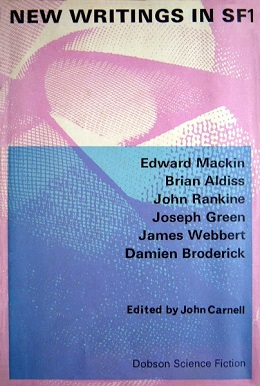
New Writings in SF 1 is an anthology of science fiction short stories edited by John Carnell, the initial volume in a series of thirty, of which he edited the first twenty-one. It was first published in hardcover by Dennis Dobson in 1964, followed by a paperback edition issued the same year by Corgi, and an American paperback edition under the slightly variant title New Writings in S-F 1 by Bantam Books in April 1966. Selections from this volume, together with others from volumes 2-4 of the series, were later included in The Best from New Writings in SF, issued by Dobson in 1971 and Corgi in 1972.

New Writings in SF was a series of thirty British science fiction original anthologies published from 1964 to 1977 under the successive editorships of John Carnell from 1964 to 1972 and Kenneth Bulmer from 1973 to 1977. There were in addition four special volumes compiling material from the regular volumes. The series showcased the work of mostly British and Commonwealth science fiction authors, and "provided a forum for a generation of newer authors."
Ralph Matthew McInerny was an American author and philosophy professor at the University of Notre Dame. McInerny's most popular mystery novels featured Father Dowling, and was later adapted into the Father Dowling Mysteries television show, which ran from 1987 to 1991.

World's Best Science Fiction: 1965 is an anthology of science fiction short stories edited by Donald A. Wollheim and Terry Carr, the first volume in a series of seven. It was first published in paperback by Ace Books in 1965. It was reprinted by the same publisher in 1970 under the alternate title World's Best Science Fiction: First Series.

Science Fiction Adventures was an American digest-size science fiction magazine, published from 1956 to 1958 by Irwin Stein's Royal Publications as a companion to Infinity Science Fiction, which had been launched in 1955. Larry Shaw was the editor for all 12 issues. Science Fiction Adventures focused on longer fiction than appeared in Infinity; these were often labeled as novels, though they were rarely longer than 20,000 words. Shaw declared in his first editorial that he wanted to bring back a "sense of wonder", and he printed straightforward action-adventure stories. Two other magazines of the period, Imagination and Imaginative Tales, had similar editorial approaches, but science fiction historian Mike Ashley considers that Science Fiction Adventures contained the best fiction of the three. Robert Silverberg was a prolific contributor, under his own name and under the pseudonym "Calvin M. Knox", and he also collaborated with Randall Garrett on two stories in the first issue, under two different pseudonyms. Other well-known writers occasionally appeared, including Harlan Ellison, Cyril M. Kornbluth, Algis Budrys, and Harry Harrison. Ed Emshwiller contributed cover art for nine of the twelve issues, and one of the other three was among John Schoenherr's earliest sales.
Science Fiction Adventures was a British digest-size science fiction magazine, published from 1958 to 1963 by Nova Publications as a companion to New Worlds and Science Fantasy. It was edited by John Carnell. Science Fiction Adventures began as a reprint of the American magazine of the same name, Science Fiction Adventures, but after only three issues the American version ceased publication. Instead of closing down the British version, which had growing circulation, Nova decided to continue publishing it with new material. The fifth issue was the last which contained stories reprinted from the American magazine, though Carnell did occasionally reprint stories thereafter from other sources.
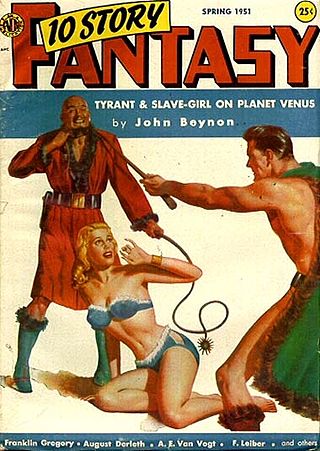
10 Story Fantasy was a science fiction and fantasy pulp magazine which was launched in 1951. The market for pulp magazines was already declining by that time, and the magazine only lasted a single issue. The stories were of generally good quality, and included work by many well-known writers, such as John Wyndham, A.E. van Vogt and Fritz Leiber. The most famous story it published was Arthur C. Clarke's "Sentinel from Eternity", which later became part of the basis of the movie 2001: A Space Odyssey.
References
- ↑ Ashley, Mike. Science Fiction Rebels: The Story of the Science-fiction Magazines from 1981 to 1990 Oxford: Oxford University Press, 2016; p. 183
- ↑ Boston, John and Damien Broderick. New Worlds: Before the New Wave, 1960-1964: The Carnell Era, Volume Two Cabin John, Maryland: Wildside Press; pp. 347-348.
- ↑ 'New Worlds Profiles: Guest Editor Edward Mackin' New Worlds October 1962 (inside front cover)